AGRICULTURAL SCIENCES GRADE 12 QUESTIONS - NSC EXAMS PAST PAPERS AND MEMOS JUNE 2019
Share via Whatsapp Join our WhatsApp Group Join our Telegram GroupAGRICULTURAL SCIENCES
GRADE 12
NSC EXAMS
PAST PAPERS AND MEMOS JUNE 2019
INSTRUCTIONS AND INFORMATION
- Write ALL the answer in your ANSWER BOOK.
- Start EACH question on a NEW page.
- Read ALL the questions carefully and answer only what is asked.
- Number the answers correctly according to the numbering system used in this question paper.
- You may use a non-programmable calculator.
- Show ALL calculations, including units and formulae, where applicable.
- Write neatly and legibly.
QUESTIONS
SECTION A
QUESTION 1
1.1 Various options are provided as possible answers to the following questions. Choose the correct answer and write only the letter (A–D) next to the question number (1.1.1–1.1.10) in the ANSWER BOOK, for example 1.1.11 A.
1.1.1 The … produce the hormones insulin and glucagon to control sugar balance in the animal’s body.
- glands of Lieberkühn
- islet of Langerhans
- Brunner’s glands
- duodenal glands
1.1.2 Hydrochloric acid changes the pH of the stomach into an acid medium which is most necessary for the actions of the enzymes …
- lipase and lactase.
- pepsinogen and bile.
- pepsin and rennin.
- rennin and succus entericus.
1.1.3 The statements below are correct with regard to the development of the forestomachs:
- Material flowing in and out of the rumen and reticulum
- Huge amounts of hydrochloric acid form in the rumen
- Presence of bacteria and its substrate in the rumen
- Presence of volatile fatty acids produced during hay fermentation
Choose the correct combination below:
- (i), (ii) and (iv)
- (ii), (iii) and (iv)
- (i), (ii) and (iii)
- (i), (iii) and (iv)
1.1.4 The following is TRUE about diffusion during absorption of nutrients:
- Gas or solute passes through a permeable membrane from higher to a lower concentration area
- No energy is required for the diffusion process
- Energy is generated through this process and used by rumen microbes
- Diffusion process stops when the concentration is at equilibrium on both sides
Choose the correct combination below:
- (i), (ii) and (iv)
- (ii), (iii) and (iv)
- (i), (ii) and (iii)
- (i), (iii) and (iv)
1.1.5 The farming instrument or equipment shown in the picture below is used by farmers to … 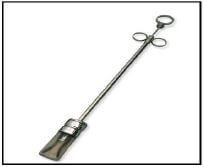
- administer liquid medication or dosing for internal parasites.
- topically apply powder, ointments and lotions on an animal’s skin.
- mix solid food and water for easy drinking.
- administer medication such as tablets and capsules or bolus to animals.
1.1.6 The picture below shows a farmer carrying a flag and crossing the road with a flock of sheep. The colour of the flag is most likely to be … 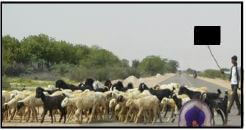
- yellow.
- white.
- red.
- blue.
1.1.7 A farm animal that is in fear, aggression and contentment will show the following warning signs:
- Pinned ears
- Pawing the ground and snorting
- Breathing very fast with its tongue outside the mouth
- Raised back hair
Choose the correct combination below:
- (i), (ii) and (iv)
- (i), (ii) and (iii)
- (ii), (iii) and (iv)
- (i), (iii) and (iv)
1.1.8 The picture below shows a farm operation where a teaser bull is used. The farm operation represented in the picture above shows the … 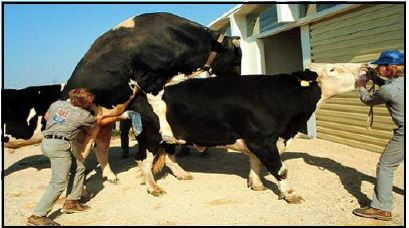
- artificial insemination.
- embryo transfer.
- mating.
- semen collection.
1.1.9 The blastocyst consists of two layers of cells. The embryo develops from the inner layer called …
- embryoblast.
- mesoderm.
- endoderm.
- trophoblast.
1.1.10 The female animal secretes … to attract bulls.
- hormones
- pheromones
- semen
- colostrum (10 x 2) (20)
1.2 Indicate whether each of the following statements in COLUMN B applies to A ONLY, B ONLY, BOTH A AND B or NONE of the items in COLUMN A. Write A only, B only, both A and B or None next to the question number (1.2.1–1.2.5) in the ANSWER BOOK, for example 1.2.6 B only.
Example:
COLUMN A | COLUMN B | |
A | Maintenance ration | The feed given to an animal to do work and synthesise output |
B | Production ration |
Answer: 1.2.6 B only
COLUMN A | COLUMN B | ||
1.2.1 | A: | Ideal for reproduction and growth | A nutritive ratio (NR) of 1 : 8 |
B: | Narrow | ||
1.2.2 | A: | Bile duct | The duct in the digestive system that opens into the duodenum |
B: | Pancreatic duct | ||
1.2.3 | A: | Fungal disease | An example is coccidiosis |
B: | Bacterial disease | ||
1.2.4 | A: | Gestation crates | Narrow stalls used in intensive farming to keep pregnant sows throughout the 16 weeks period |
B: | Farrowing pen | ||
1.2.5 | A: | Salpingitis | The condition where pus accumulates leading to infection of the uterus |
B: | Metritis |
(5 x 2) (10)
1.3 Give ONE term/phrase for each of the following descriptions. Write only the term/phrase next to the question number (1.3.1–1.3.5) in the ANSWER BOOK.
1.3.1 The condition where rumen contents produce foam that collects around the entrance to the rumen resulting in constipation and trapped gas which cannot be belched out
1.3.2 The disease common in fully grown animals where too much calcium has been removed from their skeletons resulting in porous bones
1.3.3 The identification of a disease from the examination of symptoms
1.3.4 The phenomena whereby a donor cow produces many ova during the same oestrus cycle
1.3.5 The condition when the animal possesses both male and female reproductive organs (5 x 2) (10)
1.4 Change the UNDERLINED WORD(S) in EACH of the following statements to make them TRUE. Write the appropriate word next to the question number (1.4.1–1.4.5) in the ANSWER BOOK.
1.4.1 The enzymes in the digestive system responsible for breaking down protein are lipolytic enzymes.
1.4.2 Epidemic is when a disease occurs in a population regularly and can be predicted.
1.4.3 The midpiece contains centrioles that supplies the energy for spermatozoon to move.
1.4.4 Gestation is the period after pregnancy during which a female mammal produces milk to feed their offspring.
1.4.5 Infertility is the permanent inability of an animal to reproduce successfully. (5 x 1) (5)
TOTAL SECTION A: 45
SECTION B
QUESTION 2: ANIMAL NUTRITION
Start this question on a NEW page.
2.1 The diagrams below represent the alimentary canal of farm animals.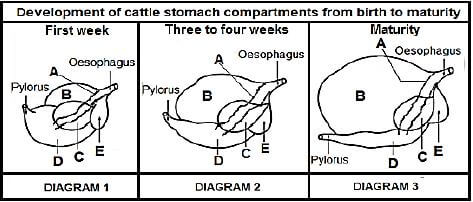
2.1.1 Identify parts A and C from the above DIAGRAMS. (2)
2.1.2 State the main function of part A in DIAGRAM 1. (1)
2.1.3 Identify the letter (A–E) that represents a true stomach from the above DIAGRAMS. (1)
2.1.4 Farm animals with the digestive system such as the one in DIAGRAM 1 should not be fed with urea or biuret. Justify the statement. (2)
2.2 The diagrams below represent the part of the alimentary canals of farm animals. 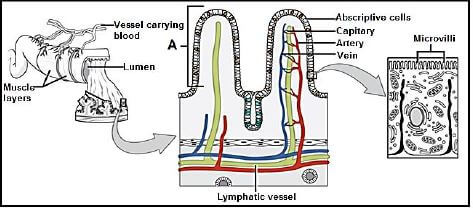
2.2.1 Identify the part labelled A from the diagram above. (1)
2.2.2 The structure above is well adapted to absorb soluble digested food molecules. Support this statement with TWO reasons visible in the diagram. (2)
2.3 Suggest the name of the diseases caused by deficiency of the following vitamin/mineral in lambs:
2.3.1 Copper (1)
2.3.2 Vitamin E (1)
2.4 The schematic representation below illustrates the energy flow of feeds. 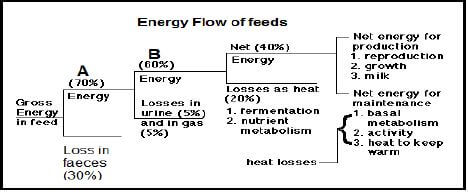
2.4.1 Identify the type of energy represented by A and B from the above schematic representation. (2)
2.4.2 Assume that the above energy flow diagram is for the cattle that consumed its feed and gained 1 250 joules of gross energy.
- Determine the amount of energy left for production and maintenance in joules. (2)
- Calculate the total energy losses and present your answer in kilojoules. (3)
2.5 Read the following scenario on compounding of two feeds. 
A small-scale pig farmer has low cost readily available grounded maize and soya bean meal available. The farmer was advised by an extension officer to use the two feeds below to formulate a mixture containing 16% DP for best performance.
2.5.1 Use the information above to determine the ratio into which the two feeds should be mixed, to achieve the required digestible protein for the herd. (4)
2.5.2 Formulate 1 500 kg of pig ration using the mixture of maize meal and soya beans meal according to the ratio determined in QUESTION 2.5.1. (5)
2.5.3 The officer advised the farmer to increase the amount of the protein rich feed in the mixture for piglets. Justify the statement with TWO reasons. (2)
2.6 The graph below illustrates a fodder-flow programme. Answer the questions that follow. 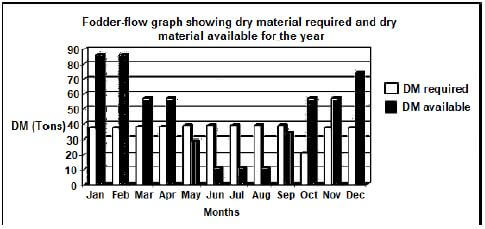
2.6.1 Deduce, from the bar graph above, the number of months during which there will be less feed available than feed required by animals. (1)
2.6.2 Calculate the surplus amount of feed during the month of October in kilograms (kg). (3)
2.6.3 Suggest TWO strategies a farmer can apply to make sure that the feed required by animals balances with the feed available throughout the year. (2) [35]
QUESTION 3: ANIMAL PRODUCTION, PROTECTION AND CONTROL
Start this question on a NEW page.
3.1 The pictures below represent two animal production systems practised in FARM A and FARM B. 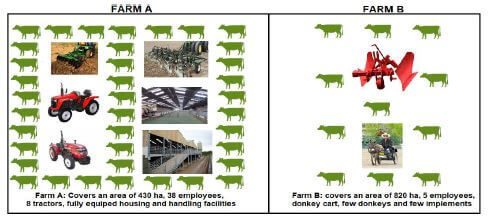
3.1.1 Identify the animal production systems represented in FARM A and FARM B in the above illustrations. (2)
3.1.2 Justify the answer to QUESTION 3.1.1 based on the pictures of FARM A and FARM B and the information provided. (2)
3.1.3 Provide an example of the animal production system that could be practised in FARM A, other than the one shown in the picture. (1)
3.1.4 Differentiate between subsistence and commercial farming systems. (2)
3.2 Read the following scenario and then answer the questions that follow.
The management of temperature in cattle is becoming more important as a result of climate change. 
3.2.1 Indicate the situation at points A and B. (2)
3.2.2 Describe how the situation explained at points A and B affects the feeding and milk production in dairy cows. (4)
3.2.3 Recommend ONE measure a farmer can take to address the challenge at points A and B for a dairy herd raised in an intensive production system. (2)
3.3 The table below shows different farming practices and the instruments used.
| Farming Practice | Lambs’ tail docking | Dehorning cattle | Branding of cattle bulls | Ear marking cattle breeds with tags | Bloodless Castration of 2 weeks old lambs |
| Name of instrument used for the practice | A | Dehorning iron or dehorning clipper | Hot iron | B | C |
Complete the table by identifying A, B and C. DO NOT copy the table. (3)
3.4 Read and analyse the following scenario to answer the questions that follow.
Bovine TB is a disease that is common to animals and can be transmitted from animals to humans as well as to other animals. Infection can also occur from direct contact with a wound or by ingesting raw (unpasteurised) milk and other dairy products from infected cows. 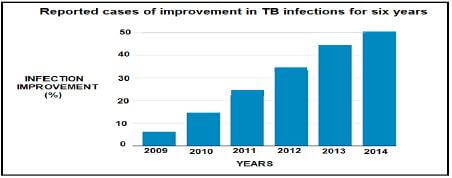
3.4.1 Name the micro-organism responsible for the disease mentioned in the above scenario. (1)
3.4.2 Extract from the above case study a statement stating that the Bovine TB is a zoonotic disease. (1)
3.4.3 Give TWO other examples of zoonotic diseases. (2)
3.4.4 Name TWO symptoms of an animal infected with TB. (2)
3.4.5 Suggest TWO methods that can be used by the farmer to prevent and control TB infection in farm animals. (2)
3.4.6 Convert the bar graph of reported cases of improvement in TB infections to a table. (5)
3.5 Describe TWO basic preventative/control measures for internal parasites. (2)
3.6 Indicate TWO roles of the state in animal protection. (2) [35]
QUESTION 4: ANIMAL REPRODUCTION
Start this question on a NEW page.
4.1 The diagram below illustrates the reproductive system of a cow. 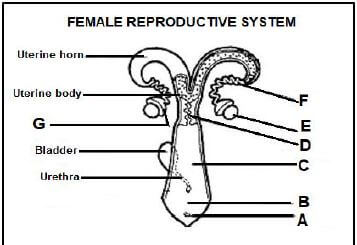
4.1.1 Identify the parts labelled G, F and B in the DIAGRAM above. (3)
4.1.2 Match the functions listed below with a letter (A–K) in the diagram above:
- Produce female gametes and hormones
- Organ of copulation
- Physical barrier to the uterus, secretes mucous that creates a cervical plug during pregnancy (3)
4.1.3 Provide the name and letter (A–K) of the female organ that becomes erects like a penis during oestrus. (2)
4.2 The diagram below illustrates different sperm cells. 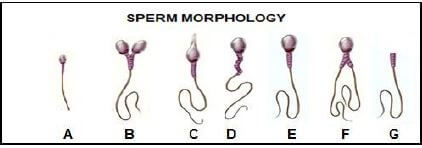
4.2.1 Identify the letter (A–G) in the diagram above that represents a sperm cell with normal morphology. (1)
4.2.2 Name the process by which sperm cells are formed in the male testis. (1)
4.2.3 Explain how sperm cells A and G can cause infertility in a bull. (2)
4.2.4 List TWO characteristics of good quality semen. (2)
4.3 The graph below represents the levels of hormones at different stages in the oestrus cycle of a cow. 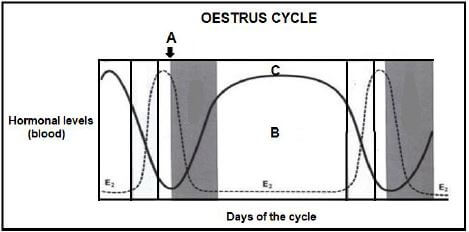
4.3.1 Name the hormone labelled C. (1)
4.3.2 Indicate with a reason the stage of oestrus cycle indicated by the letter B. (2)
4.3.3 Name the process represented by A in the graph above. (1)
4.3.4 Name TWO visible signs of a cow on oestrus. (2)
4.4 The list below represents stages of mating or copulation:
- Gaining intromission into the vagina
- Ejaculation of semen into vagina
- Mounting
- Erection of the penis
Re-arrange the stages of mating presented in the list above into its chronological order. (4)
4.5 The table below represents different procedures, 1, 2 and 3, that are used in animal reproduction.
| PROCEDURE 1 | PROCEDURE 2 | PROCEDURE 3 |
| Semen of selected farm animals is collected, processed and used for animal reproduction | Many embryos are harvested from selected farm animals then used for reproduction | Nucleus of a cell from one animal is removed and placed into aprepared egg cell to be used for reproduction |
Identify the procedure in animal reproduction (1, 2 or 3) that is associated with the following:
- Embryo transplantation (1)
- Cloning (1)
- Artificial insemination (1)
4.6 The diagrams below represent a cow at different stages of parturition. 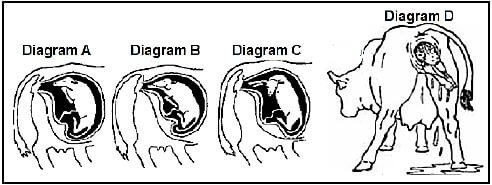
4.6.1 Name the stage of parturition represented by DIAGRAMS A and D respectively. (2)
4.6.2 Provide TWO signs of parturition that could be seen in a cow before stage D. (2)
4.7 The following graph represents the relationship between the milk yield over a number of days: 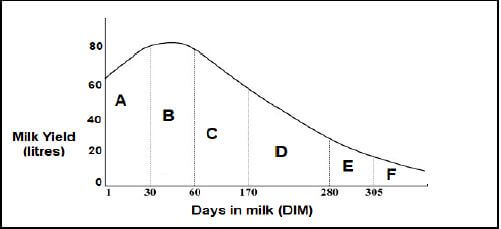
4.7.1 Give the name of the graph presented above. (1)
4.7.2 Identify the range of days during which milk production is at its peak. (1)
4.7.3 Name TWO factors that influences the amount of milk produced by a cow during the peak period. (2) [35]
TOTAL SECTION B: 105
GRAND TOTAL: 150